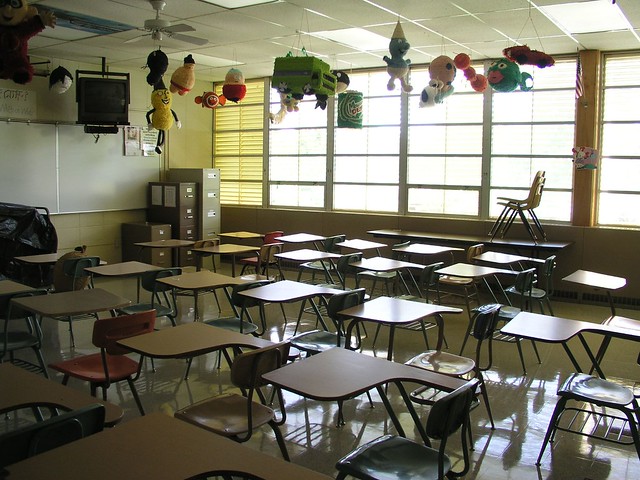A majority (55%) say they have heard nothing at all about the Smarter Balanced Assessment System, which replaces paper-based tests. The new tests are based on the Common Core math and English standards. About a third of public school parents (36%) have heard a little about the tests, and just 8 percent say they have heard a lot. Latino public school parents (54%) are much more likely than white parents (32%) to say they have heard about the tests.
While concerns have been raised about whether all schools have enough computers, bandwidth, and technology staff to effectively administer the online tests, most public school parents say they are very confident (29%) or somewhat confident (42%) that their local schools do.
Other states have found that the switch to the Common Core standards and new tests significantly reduced student scores. How do California public school parents expect students to score on the Smarter Balanced tests? A plurality (42%) predict that scores will be about the same as those on past tests, while 29 percent expect scores to be higher and 23 percent predict that they will be lower.
More generally, Californians are divided about whether standardized tests are accurate measures of a student’s progress and abilities, with 51 percent very or somewhat confident that this is true, and 46 percent not too confident or not at all confident. But few say there is too much testing in their local schools (24% too much in elementary and middle schools, 22% too much in high schools).
A year after the Common Core State Standards were implemented, 66 percent of public school parents have heard of them (43% a little, 23% a lot), while a third (32%) say they have heard nothing at all. White public school parents are nearly three times as likely as Latinos to say they have heard a lot (38% vs. 13%).
A third of public school parents (34%) say their child’s school or district has provided them with information about the Common Core standards and that this information has been adequate. But 20 percent say they have received inadequate information, and the largest share of parents (42%) say they received no information about the standards.
"Many public school parents are in the dark when it comes to Common Core," said Mark Baldassare, PPIC president and CEO. "Local schools need to do a better job of keeping parents informed as the state implements the new English and math standards.”
Based on what they’ve read and heard about Common Core, 47 percent of adults and 57 percent of public school parents favor the standards. There is a partisan divide, with Democrats (49%) much more likely to be in favor than independents (37%) or Republicans (30%).
Concerns have been raised about teachers’ readiness to teach the new standards—concerns that are shared by California adults (73% very or somewhat concerned) and public school parents (80% very or somewhat concerned). But Californians are optimistic that Common Core will meet two goals: Most (57%) are confident that implementing the standards will make students more college or career ready, and most (57%) are confident that the standards will help students develop critical thinking and problem solving skills. Public school parents express even higher levels of optimism (71% confident about each goal).
Baldassare summed up: "Most Californians are hopeful about the effect of Common Core on improving student achievement, but many worry that teachers are not fully prepared to implement these new standards in the classroom.”
Across racial/ethnic groups, Latinos are much more likely than other groups to express confidence that Common Core will make students more college and career ready (75% Latinos, 65% Asians, 58% blacks, 44% whites) and help students develop critical thinking and problem solving skills (77% Latinos, 60% blacks, 51% Asians, 45% whites). Yet Latinos are also the most likely to express concerns about teacher preparedness to implement the standards (80% Latinos, 79% blacks, 70% Asians, 67% whites).
Most Expect New Funding Formula To Boost Achievement
As the state implements a new system for financing schools—the Local Control Funding Formula (LCFF)—most Californians say they have heard nothing about it (75% adults, 69% public school parents). Across racial/ethnic groups, Latinos (30%) are the most likely to have heard a little or a lot about the LCFF, followed by Asians (27%), blacks (20%), and whites (19%).
When they are read a brief description of the LCFF, strong majorities of adults (70%) and public school parents (73%) favor it. Among those who have heard at least a little about the LCFF, 75 percent favor it.
The LCFF allocates extra money to districts with more English Learners and lower-income students. Californians have long expressed the view in PPIC surveys that school districts in lower-income areas of the state lack the same resources—including good teachers and classroom materials—as those in wealthier areas. Today, 82 percent hold this view, which is consistent with their support of the LCFF. A majority (59%) also say they are very concerned that students in lower-income areas are less likely than other students to be ready for college when they finish high school. About half of Californians (48%) say they are very concerned that English Learners score lower on standardized tests than other students.
The LCFF allows local districts more control over spending decisions, and it gives additional funding to districts with more lower-income students and English Learners. How confident are Californians that districts receiving the extra money will spend it to support these students? Most adults (56%) are at least somewhat confident, and public school parents (66%) are especially likely to express this view. Will the LCFF improve academic achievement of English Learners and lower-income students? Strong majorities of adults (68%) and public school parents (78%) say it will, at least somewhat. Latinos (85%) are much more likely to expect improvement than Asians (67%), blacks (62%), and whites (59%).
The LCFF requires each school district to get input from parents in designing a Local Control Accountability Plan. While 42 percent of public school parents say they were given information about how to get involved, most (54%) say they did not receive any. Lower-income parents (51% of those with household incomes under $40,000) were much more likely than wealthier parents (37% of those with incomes of $40,000 or more) to say their child’s school or district provided them with information.
Among the parents who received information about participating, most (72%) say they were not involved in the process. Notably, public school parents with lower household income are more likely than those with higher incomes to be involved (25% with incomes under $40,000 vs. 8% $40,000 or more).
State Funding For Schools Is Up, But Most Say It’s Not Enough
California funding for K–12 public education has been rising in recent years, but 60 percent of all adults and 70 percent of public school parents today say current state funding for their local public schools is not enough. Among likely voters, 54 percent say there is not enough funding. Asked to identify the most important issues facing public education today, Californians are most likely to mention lack of funding (16%) and quality of teachers (12%). Public school parents are most likely to mention lack of funding (18%), large class sizes (13%), and quality of teachers (12%).
How do residents think California K–12 education compares to that of other states? About a third of adults (35%) say California’s spending per pupil is lower than average and 26 percent say it is higher than average. Only 29 percent correctly say that spending per pupil is average. Asked about K–12 test scores, 46 percent correctly say California’s results are lower than average (11% higher than average, 38% average).
How can California significantly improve the quality of public schools? Just 9 percent say increased funding alone will do this, while 38 percent prefer using existing funding more wisely. The largest share (49%) prefers that the state do both.
The survey also asks a series of questions about ways to fund education projects.
A state bond for school construction projects: 66 percent of adults and 55 percent of likely voters say they would vote yes if there were a measure on the ballot.
A local bond for school construction projects: 65 percent of adults and 53 percent of likely voters would vote yes if their local districts put a measure on the ballot. (A 55% majority vote is required for passage.)
A local parcel tax for schools: 57 percent of adults and 49 percent of likely voters would approve an increase in local parcel taxes to benefit local schools. (A two-thirds majority vote is required for passage.) Half of adults (50%) think it is a good idea to replace the two-thirds requirement with a 55 percent majority vote to pass local parcel taxes for local public schools. However, only 44 percent of likely voters express support—short of the majority vote required to make the change.
More Key Findings
Half approve of Brown’s job performance—page 14
The governor’s approval rating is holding steady (50% adults, 53% likely voters), as is the legislature’s (42% adults, 36% likely voters). Approval of the way both the governor and legislature are handling of K–12 education is lower.
Local schools get record-high ratings for college, career preparation—page 18
Most adults (58%) say their local public schools are doing a good to excellent job of preparing students for college, and 48 percent rate their schools as good to excellent when asked how well they are preparing students for the workforce.
Half give local schools an A or B—page 20
While 53 percent of all adults give their neighborhood schools good grades, blacks are much less likely than other racial/ethnic groups to do so (blacks 38%, whites 50%, Latinos 59%, Asians 63%).
via: http://www.ppic.org/main/pressrelease.asp?i=1751






